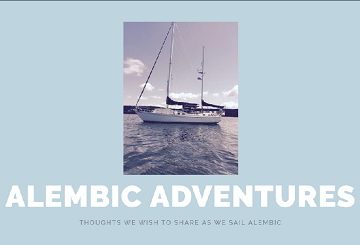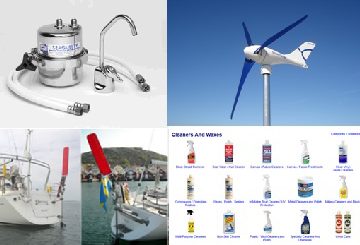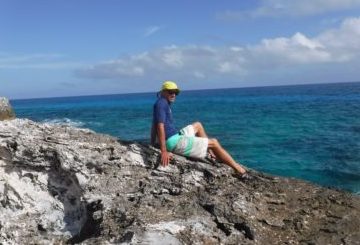
Motoring away from the Açores in calm water
Leaving the Açores was hard. We had fallen in love with the islands, the locals, the fellow cruisers, the food, everything. And we were facing a ten day trip to Ireland that could be our most challenging trip ever. Many cruisers had reported lack of wind, with several of our friends’ boats being towed in when they ran out of diesel! Others had rough passages and rerouted to new places to ease the trip. Luckily, we had no firm plans, nobody meeting us at the other end, so we could “go where the wind blows us”.
We had studied so many weather reports from Chris Parker, FastSeas, PredictWind, Spots, Grib files, and many more sites. All reports seemed to vary slightly, but generally assure us that there would be enough, and not too much, wind to get us to Ireland. So off we went with Alexandra V, a sailboat with a Polish couple on board, not far behind us. We had compared notes and planned communication strategies with these new friends. Sailing in the company of others is always comforting.

A Green Flash for our first sunset
The first day was mellow. A light drizzle cleared away to bring bright sunshine, enough wind on the beam to sail, and the most spectacular Green Flash. If you haven’t seen one, keep watching. You need a clear horizon on the water, and a mostly cloud free sky. A bit of cloud actually helps bring out the colors and the last color as the sun disappears is green. Sometimes it is so tiny, you barely see it, while at other times it feels like someone has flicked a switch to illuminate a bright green blaze. This night, it was tiny, but clear, leading the way for a night of bright stars.
That was the end of the peace. By noon the next day, squalls arrived and the winds started playing games on us, varying from 5 to 25 knots and from northeast to west. Our wind vane, which steers the boat relative to the wind angle, had to be constantly adjusted or else our path would have been like that of a very confused drunk. The sails also required frequent tweaking. After taking down the pole, we used the genoa like a throttle, letting it fly when the winds were light, then partially furling it in as the winds picked up. The mizzen sail only needed sheeting in and out, while the main was reefed, double reefed, hoisted back up, and reefed again, as the nearby weather system flirted with our path to Ireland.

The huge waves kept us rolling along
By the third day, the parade of squalls and the variable winds continued to keep us busy. Bill tied in a third reef line so we would be prepared to make our mainsail as small as a handkerchief. Luckily, we never did sail triple reefed, but we did heave to that night for three hours. This requires us to drop all sails except our reefed mizzen and lock the wheel to steer into the wind. The mizzen drives the boat into the wind, and the rudder also tries to steer into the wind. Alembic loses all momentum as it tries to come about and falls off the wind again. Meanwhile, we get to sit back and rest, while the boat just pokes along at about one knot in a direction about 60 degrees off the wind. This is a technique many sailors use to quiet the wild boat motion down. We even know sailors who do this to make a meal, or go to the head!

Our Spot for days 4-9. Reality: double the windspeed and add a meter to the wave height.
After sailing northeast for three days, we turned to more due east to try to get south of these weather systems that were moving north of us. The trick to sailing in this part of the Atlantic is to go close enough to the low pressure systems moving generally westward to take advantage of the wind they provide, but stay enough south of them to avoid gales. While we were in no danger, and the systems were not hurricanes, we were getting tired of the strong winds and large seas.
Switching to the autopilot on the fifth day helped us steer closer to our course and prevent some of the slatting of the sails and gear. This device steers a heading on the compass, so the line is straighter, but it consumes electricity, which we always try to conserve on passages. The wind vane uses no electricity, but the large waves shove Alembic off track, and the vane struggles to stay on course, causing near gybes every few minutes. Alembic looked like a spiderweb with all of the preventers keeping the booms from gybing. When we felt we could maintain a somewhat straight course with the vane, we switched back.

I was always cold on this trip. Staying below, with ski gear on.
Spotting wild life was infrequent on this trip. The seabirds were solo and far between. Random pieces of fishing gear were spotted but too far off to pick up. Usually, we try to grab these and deliver them back to shore where fishermen can reemploy the gear instead of leaving them out here as pollution. The one whale we spotted was dead, sadly, with a gathering of small black storm petrels feasting.

Our Spot for days 6, 7, 8. Add 10 knots to column 6 and a meter to column 8
Heaving to for four hours on the sixth day gave us relief again from the relentless wind and seas. 15 to 25 knots, with gusts to 38 were the norm and the boat kept surfing up and down the twelve foot seas. We finally dropped both main and mizzen and sailed under genoa alone for the next two days while the winds varied from ten to over thirty with many squalls rolling by.

Bill has a smooth forehead

Not such a pretty stitch job

Back to sleeping on watch in his pre-fall position
The worst night was the eighth when Bill fell in the cockpit. He dosed while sitting on the port side. A wave rolled the boat, and Bill flopped over to the starboard side, hitting his head on the coaming (the seat back). A gash opened up, just above his eyebrow, requiring stitches. Maybe it was because I was sound asleep one moment and staring at a gaping hole in his head the next, but I sure confirmed that night that I would not make a great nurse. First I was freezing (yeah it was super cold), then I was having a full body sweat (did I put on too many clothes?) and the next thing I know, Bill has a mirror and he’s saying “I’ll do this myself”. Not a proud moment for me!! I gathered my wits, smeared New Skin on the gash, and watched as it opened back up like a fish mouth. Stitches seemed like a bad idea in the pitching seas, so I resorted to placing four steri stitches and more glue. This seemed to work and we called it good. I promptly sent Bill to bed and I took over in the cockpit. I certainly wasn’t going to be able to sleep after this incident! Luckily Bill has a gift and can sleep wherever and whenever!
Our ninth day was more of the same weather, with plenty of rain to add to our discomfort. The poled out genoa and mizzen kept us moving along though, so we were generally pleased with our progress. By the end of this day we began to see many boats on our AIS, giving us a lift in spirits as this surely indicated that we were closing in on LAND!
Fog came in to replace the wind on our last day. Family members placed guesses on when we would first spot land. They each picked a time that would be when we first saw a light, a mountain, a building, anything on land. They could see our progress on our inReach tracking online, so they knew exactly how many miles we were from mountain peaks and river mouths. Sadly, we actually entered the river, smelling cows and hearing voices, but never saw land! After carefully arriving with radar guiding us, we dropped our anchor in a narrow river.
And went straight to SLEEP!!

Fort Charles was our first sight of land

Alexandra V came in safely
The next morning we jumped out of bed to look out and see…..fog. Still no land. I went back below to make a pancake feast and Bill shouted “Land!” I can’t even explain the ecstasy of watching the curtain rise to reveal the most gorgeous sight: Fort Charles and glorious Kinsale Ireland and our friends on Alexandra V motoring by. We had arrived safely and on schedule, with full tanks of diesel, no damage to Alembic, and only a small healing wound. Phew, time to thank the Angels.

Now that the fog lifted, we motored in to town






























































































































































































































